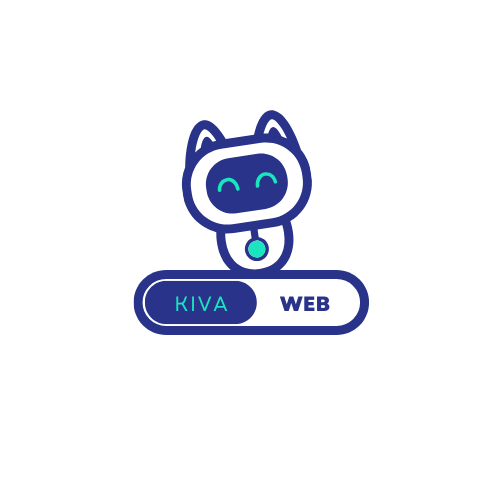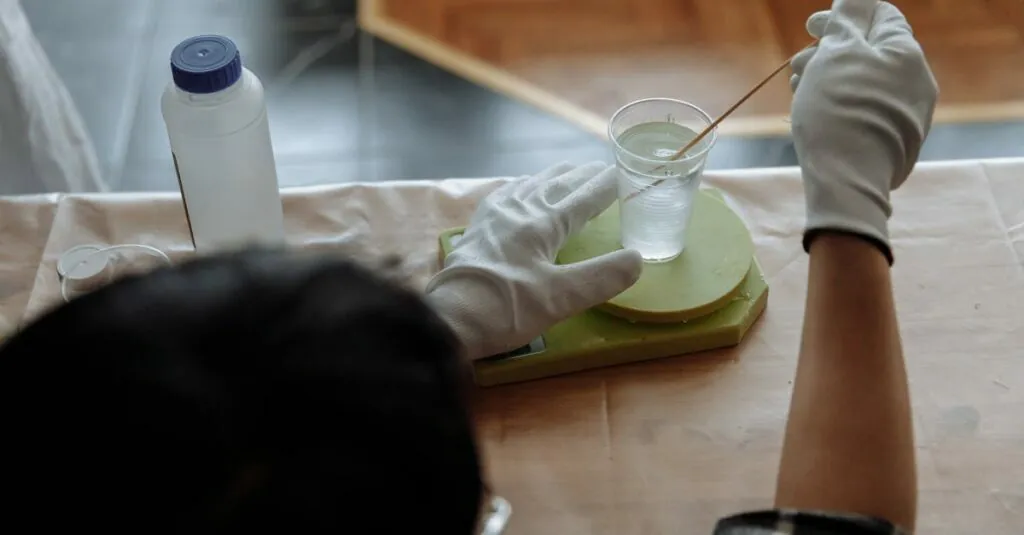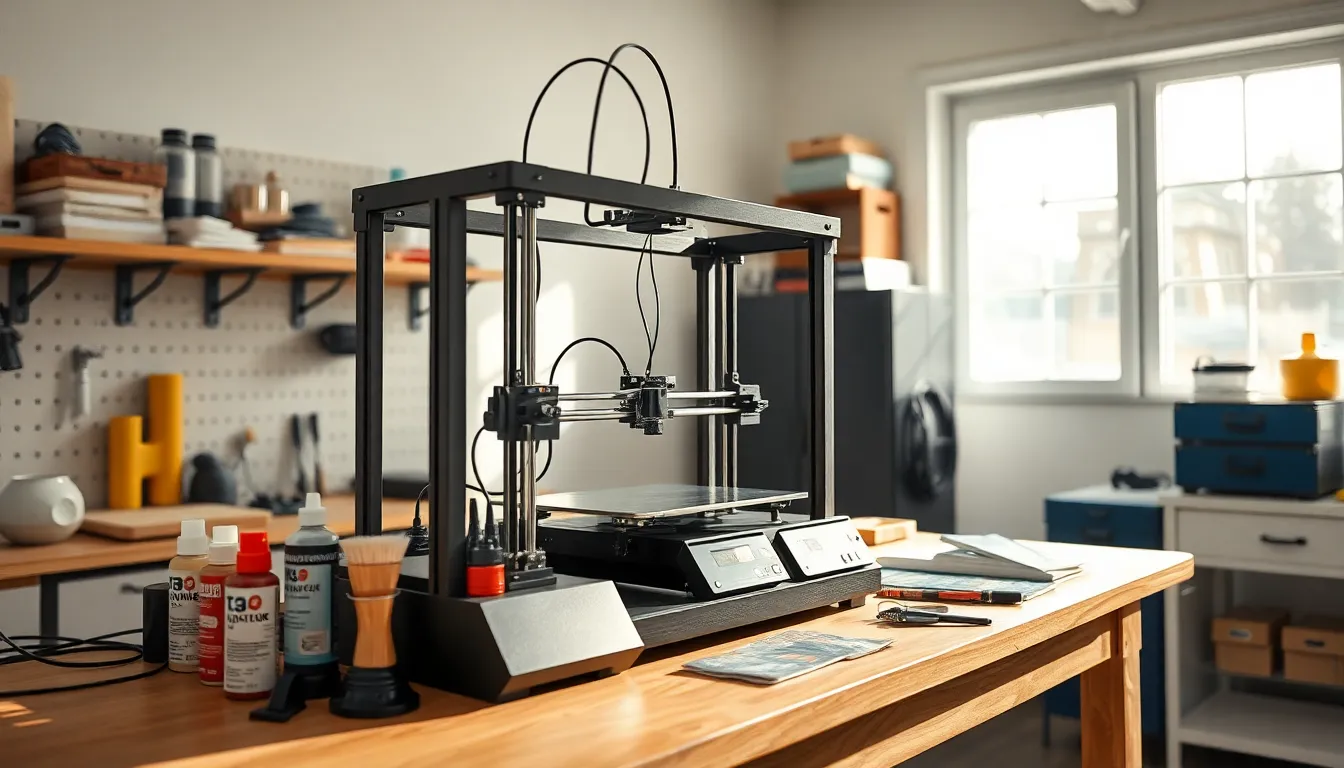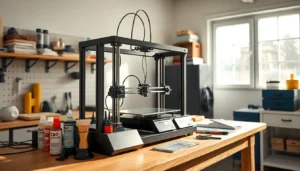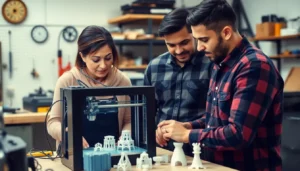Resin printing can turn creative dreams into tangible realities, but it’s not all sunshine and rainbows. Think of it like a thrilling roller coaster ride—exciting but with a few safety harnesses you definitely don’t want to skip. As enthusiasts dive into the world of resin printers, understanding safety precautions is crucial to avoid turning a fun hobby into a hazardous adventure.
Table of Contents
ToggleUnderstanding Resin Printer Safety
Resin printing offers a world of creativity, yet understanding safety measures is crucial. Proper precautions ensure a safe and enjoyable experience.
Importance of Safety Precautions
Safety precautions protect users from potential hazards. They promote a safe workspace, reducing risks associated with chemicals. Wearing gloves, masks, and goggles serves as essential protective gear. Proper ventilation minimizes inhalation of fumes during printing. Awareness of material safety data sheets provides users with vital information on handling and emergency procedures. Following guidelines leads to safer practices overall.
Common Risks Associated with Resin Printing
Resin printing encompasses several risks. Exposure to resin can cause skin irritation or allergic reactions. Inhalation of fumes poses respiratory hazards, especially in poorly ventilated areas. Resin spills create slippery surfaces, increasing the risk of slips or falls. Incorrect handling of cured resin may result in injury due to sharp edges. Understanding these risks contributes to a safer printing environment.
Personal Protective Equipment (PPE) for Resin Printing
Proper use of personal protective equipment significantly enhances safety during resin printing. Prioritizing protection not only prevents injuries but also promotes a more enjoyable experience.
Essential Gear for Safety
Selecting the right safety gear is crucial. Nitrile gloves shield hands from resin exposure. Safety goggles protect eyes from splashes and UV light. Respirators or masks with organic vapor cartridges minimize inhalation of harmful fumes. Protective clothing prevents skin contact, particularly in areas prone to spills. Having the appropriate gear on hand establishes a safer workspace.
Recommended PPE Guidelines
Following PPE guidelines ensures maximum safety. Always wear nitrile gloves when handling resin or cured objects. Use goggles that provide a secure fit and offer full coverage of the eyes. Respirators should meet NIOSH standards for effective filtration of harmful vapors. It’s advisable to opt for long-sleeved clothing to minimize skin exposure to resin. Ensure proper ventilation in the workspace to further reduce inhalation risks from fumes.
Safe Handling of Resin
Safe handling of resin involves implementing key practices to protect health and minimize risks. Following specific guidelines ensures a more enjoyable resin printing experience.
Proper Storage Practices
Storing resin correctly prevents unnecessary exposure and accidents. Keep resin in a cool, dark place to maintain its quality. Containers should be tightly sealed to avoid spills. Designate a dedicated storage area to minimize contamination risks. Avoid placing resin near heat sources or direct sunlight, as these can alter its properties. Label all containers clearly to prevent confusion or misuse. Using a secondary containment system can enhance safety by containing potential leaks or spills.
Tips for Handling Liquid Resin
Handling liquid resin requires careful attention to avoid mishaps. Always wear appropriate PPE, such as nitrile gloves and goggles, when working with resin. Avoid direct contact with skin and eye exposure. When pouring resin, work slowly to maintain control, preventing splashes. Using a funnel can help guide resin into molds more precisely. Clean any spills immediately using appropriate cleaning materials, and dispose of them according to local regulations. Ensure proper ventilation in the workspace to reduce inhalation risks associated with resin fumes.
Ventilation and Workspace Safety
Maintaining proper ventilation and a safe workspace during resin printing is crucial for minimizing health risks. Ensuring adequate airflow helps reduce the concentration of harmful fumes associated with resin.
Importance of Good Airflow
Good airflow plays a significant role in reducing inhalation of toxic fumes generated during the printing process. Having open windows, exhaust fans, or air purifiers can significantly improve indoor air quality. Many users opt for a designated workspace with ventilation systems in place to facilitate a safer environment. Indoor air quality becomes better with adequate circulation, leading to a more comfortable printing experience. Furthermore, consistent airflow helps prevent odor build-up, making it easier to work without distractions.
Setting Up a Safe Printing Environment
Creating a safe printing environment requires careful planning and consideration. First, select an area away from high-traffic zones where spills or accidents could occur. Next, utilize surfaces that are resistant to resin, like plastic or silicone mats, to protect underlying materials. Additionally, keeping materials organized reduces clutter and enhances safety. Using dedicated storage containers for resin and tools prevents accidental exposure to hazardous materials. Lastly, ensuring that personal protective equipment is within easy reach reinforces safe practices and promotes adherence to safety protocols.
Emergency Procedures and First Aid
Immediate response to exposure is crucial in reducing potential harm. Individuals should follow specific steps to address any incidents effectively.
What to Do in Case of Exposure
If resin comes into contact with skin, rinse the area thoroughly with soap and lukewarm water for at least 15 minutes. Remove contaminated clothing promptly to minimize further contact. If resin enters the eyes, flush them immediately with clean water for 15 minutes while keeping the affected eye open. For inhalation of fumes, exit the area and move to fresh air. Seek medical attention if symptoms persist or worsen. Reporting incidents to a supervisor can help document the exposure and improve workplace safety.
First Aid Measures for Chemical Burns
In the event of a chemical burn, rinsing the affected area with clean water for a minimum of 20 minutes is essential. Remove any jewelry or clothing near the burn if it does not stick to the skin. Cover the burn with a sterile, non-adhesive bandage to protect it from infection. Seek immediate medical assistance for burns that cover a large area or are severe. Avoid applying ointments or creams, as these can exacerbate the burn’s effects. Keeping the individual calm during the process minimizes further injury and helps manage pain.
Conclusion
Resin printing offers incredible opportunities for creativity but prioritizing safety is essential. By following the recommended precautions and using appropriate personal protective equipment, individuals can significantly reduce risks associated with this hobby. Maintaining a well-ventilated workspace and practicing proper resin handling and storage further enhances safety. With awareness and diligence, enthusiasts can enjoy the thrilling process of resin printing while protecting themselves from potential hazards. Embracing safety measures not only fosters a secure environment but also enriches the overall creative experience.
